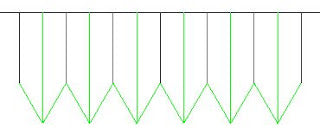Rock anchor construction is used to anchor structures into rock. Structures are anchored into the rock to maintain their stability or to support the load of structural elements such as walls, foundations, etc. Different types of forces acting on structures are transmitted as tensile forces, comprehensive forces or shear forces.
Depending on the stress transmission method, the anchors are dimensioned. The construction of anchors for transmitting tensile forces is explained in this article. Three main factors are taken into consideration during construction.
- Permissible bonding stress between steel and mortar
- Allowable bonding stress between mortar and rock
- Check for loosening of rock masses
For example, consider tank design in terms of buoyancy.
The following equations are used in tie design.
Actual Force on each anchor = Unbalanced thrust pressure / Number of anchors required per unit area… 01
D Depth of the anchor rods in the rock mass = Real force in each anchor / (π x d1 x F1). 02
D Depth of the anchor rods in the rock mass = Real force in each anchor / (π x d2 x F2). 03
C Tensile failure test of steel
Where
F1 – Permissible bonding stress between steel and grout
F2 – Allowable bonding stress between soil and rock
d1 – diameter of the anchor rod
d2 – diameter of the anchoring hole
F1 and F2 may vary depending on local conditions. However, conservative values can be found in relevant books.
The basic steps in constructing risers are as follows
Calculate the unequal buoyant force acting on the anchors. This can be calculated by subtracting the weight of the structure from the buoyancy force.
Choose a sustainable post diameter. This could be based on the experience of the poles, which could be followed through trial and error.
Calculate the allowable tensile stress of the reinforcement. The tensile stress can be assumed to be 0.87 times the yield strength of the bars (according to the British Code).
Calculate the force that the bar can withstand without breaking due to tension. (= 0.87 x fy x ae of a rod)
Calculate the number of anchors and their spacing based on the applied force and anchor capacity.
The depth of the anchor rods can also be calculated using equations 02 and 03. Any greater depth applies.
Check whether the anchored rock mass releases against buoyancy forces. To calculate the weight of the rock mass that can be lifted by the anchors, a wedge can be considered, as shown in the figure below. An angle of 22.5 degrees between the anchor and the inclined plane can be taken into account for the calculation.

